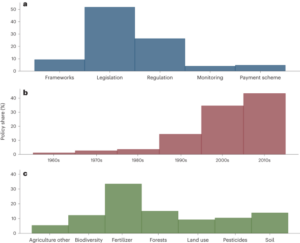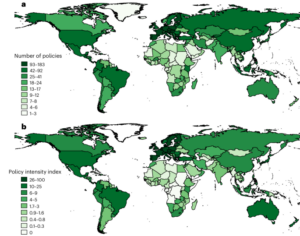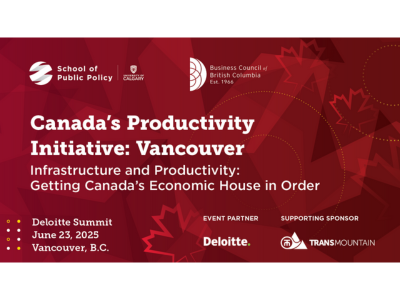Agri-Environmental Policies: Measuring Efficacy

Designing and implementing agri-environmental policies comes with high stakes for global agriculture and food systems that are vital for human well-being. They can also affect greenhouse gas emissions, biodiversity loss, land degradation and nutrient pollution. One of the keys questions must therefore be How do we know such policies are working?
First of all, what do we mean by agri-environmental policies. How do we define them? Then what do we mean by “work?” How do we know for sure that a policy is working, has worked, will continue to work long-term? Sometimes, the results we see are part of a much bigger story context about what works.
A recent paper by Wuepper et al. (2024)1 looked into the effectiveness of 6,124 agri-environmental policies implemented from 1960 to 2022 in approximately 200 countries. The policies included ‘command and control’ measures such as legislation and regulations, payment schemes, goals for biodiversity conservation, safer pesticide use, and reducing nutrient pollution.
The study focused specifically on the association between economic development and agri-environmental policies, and between the soil-related, agri-environmental policies of countries sharing borders in order to compare levels of cropland erosion. As such a large-scale database, it provides numerous and fascinating at-a-glance comparisons. (See Fig. 1.)

Fig. 1 Agri-environmental policies from 1960 to 2022
A valuable insight of the study was a global comparison of the number of agri-environmental policies (see Fig. 2). As we might expect, policies are distributed unequally.
A simple count of agri-environmental policy efforts does not reveal the ambition, targeting, stringency and enforcement of policies. Taking into account such factors as enforcement stringency and corruption levels, the researchers also present the global policy distribution with a different metric: the policy intensity index. Russia and China are just two nations whose profile changes according to that index.
Countries with a higher GDP tend to implement more agri-environmental policies than those with a lower GDP, excepting some richer countries such as Kuwait, Qatar or the United Arab Emirates. Richer countries also tend to use more heavily regulated aspects of agriculture such as fertilizers and pesticides, so it’s logical that they would have more targets and legislation. EU member states, meanwhile, are subject to a double layer of policy: their own and those of the EU.

Fig. 2 Number of agri-environmental policies and policy intensity index per country.
The Wuepper paper also looked at comparative soil erosion in the border regions between countries, taking into account the difference between natural erosion determinants (e.g. rainfall and soil characteristics), and socio-economic characteristics such as GDP, Environmental Performance Index (EPI), corruption and private property index).
The researchers found that at least 43% of all global border inconsistencies in soil erosion between countries can be explained by differences in their policies. However, it remains unclear exactly from where the impact derives. It could be accounted for by differences in the policies themselves but also in the nature of institutions, economic structures, development, culture, trade and multiple other factors.
The trade-off factor
The difficulty in identifying precisely how policy works nationally, transnationally and internationally brings us to a different level of analysis. No policy exists in a vacuum. Any effective agri-environmental policy will be affected and will affect other socioeconomic activity and possibly also other agri-environmental policies, nationally and globally.
Hannah Ritchie considered such trade-offs in a recent article.2 She notes that in 2021, for instance, Sri Lanka banned the import of chemical fertilizers, aiming to provide a toxin-free diet and promote organic agriculture. It was ostensibly a bold and beneficial agri-environmental policy. Fertilizer use dropped dramatically. However, the policy change also caused a rise in agrochemical prices and ultimately a 52% loss in yield. Rice production fell by almost 40% from 2021 to 2022.3
Organic fertilizer usage did increase in Sri Lanka, but only 1% of farmers preferred fully organic farming compared to 56% preferring chemical fertilizers. The intended shift to complete organic cultivation was unsustainable.
Clearly, this was not a balanced or well-planned policy. A better approach would have been a combination of conventional and organic based agriculture systems combined with more environmentally and economically sustainable fertilizer policies. This would have given farmers time to find alternative nutrients and to learn more about organic production.
Another example of trade-offs is seen in the Americas and in Asia. These territories manifest an inverse relationship between pesticide pollution and cropland soil erosion because soil conservation with reduced tillage or no-till farming is practiced widely. Such practices often require reliance on chemical pest management. Mitigating or eliminating this conflict might be achieved by encouraging the use of low- or no-pesticide input soil conservation practices, which in turn could be achieved by increasing agricultural R&D spending, and by optimizing extension services.
In many trade-off situations, we see an unforeseen domino effect. A study in Nature Communications,4 examined what would happen to greenhouse gas (GHG) emissions from agriculture if England and Wales took a 100% shift to organic food production. The prediction was for a reduction of domestic GHG emissions but also major shortfalls in production of most agricultural products. Meeting this shortfall through land conversion overseas (and importation transport) would result in greater overall GHG emissions, of which enhanced soil carbon sequestration would offset only a minor part.
Evidently, policy-making needs to look beyond national metrics to consider the global scope of change. Such an approach is already seen in calculations of fossil-fuel-derived carbon dioxide emissions, which assess not only consumption-based emissions but also associated emissions from imported goods and services.
Trase Earth – founded in 2015 by the Stockholm Environment Institute and Global Canopy – is an example of multi-perspective assessment. It combines data on commodity production and trade from multiple sources to map the supply chains of products such as beef, palm oil, soy, and cocoa, showing links between consumer markets, traders and production regions.
Again, the question: How do we know agri-environmental policies are working? Perhaps the question should be, In what ways, where, when, how, and for how long do agri-environmental policies work? Therein lies the key to effective policy-making on a global scale.
NOTES
- David Wuepper, Ilsabe Wiebecke, Lara Meier, Sarah Vogelsanger, Selina Bramato, Andrea Fürholz & Robert Finger (2024). Agri-environmental policies from1960 to 2022. Nature Food, vol.5, pp.323-31. https://doi.org/10.1038/s43016-024-00945-8
- Hannah Ritchie (2024). How effective are policies in reducing the environmental impacts of agriculture? OurWorldInData.org. https://ourworldindata.org/effective-policies-reducing-environmental-impacts-agriculture
- Import Ban on Chemical Fertilizers and Other Agrochemicals: Short-term Impacts on Selected PFCS and Potato Crop (December 2022) https://reliefweb.int/report/sri-lanka/import-ban-chemical-fertilizers-and-other-agrochemicals-short-term-impacts-selected-pfcs-and-potato-crop-december-2022#:~:text=In%20April%202021%2C%20the%20Sri,agrochemicals%2C%20resulting%20in%20yield%20loss
- Smith, L. G., Kirk, G. J., Jones, P. J., & Williams, A. G. (2019). The greenhouse gas impacts of converting food production in England and Wales to organic methods. Nature Communications. https://www.nature.com/articles/s41467-019-12622-7


